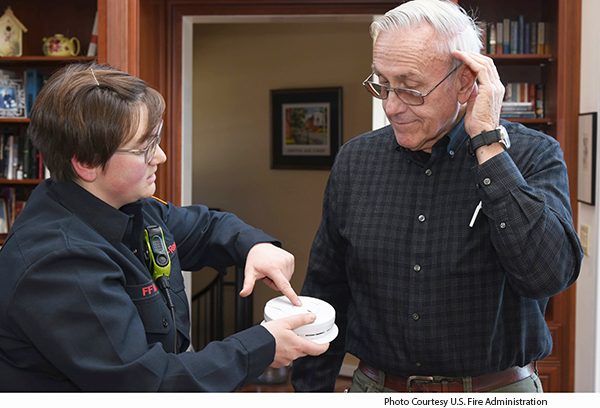
Test smoke alarms regularly, and make sure senior occupants can hear them from any room.
It’s a sad, but true, statistic that older adults are more likely to die in a home fire than the general population. According to the U.S Fire Administration, adults 65 and older are 2.2 times more likely to die in a fire, and that number increases to 4.0 times more likely when they reach age 85. Although older adults represented 16.9 percent of our population, they suffered 30 percent of home fire deaths in 2020. Government statistics show older adults are the fastest-growing segment of the U.S. population.
Many factors make fire safety more challenging for an older adult, including reduced mobility and physical, cognitive and sensory limitations that may put them at greater risk of death or injury.
Compounding our concern is the fact that many older adults are unable to afford necessary home improvements that could substantially reduce their risk of fire.
Visit an older adult in your life and help him or her take these steps to improve home fire safety:
-
- Place smoke alarms on every level of the home and inside and outside of sleeping areas

- Test smoke alarms each month
- Assure that smoke alarms are less than 10 years old
- Make sure occupants can hear smoke alarms from any room; Smoke alarms with strobe lights and pillow vibrators are available for the hearing impaired.
- Smoke outside only, never in a bed or around medical oxygen
- Develop a fire escape plan that shows two ways out of every room
- Make sure escape plans consider everyone’s needs, including those who use a wheelchair, cane, hearing aid or glasses
- Practice the escape plan at least twice a year
The U.S. Fire Administration offers additional resources to educate older adults about the importance of home fire safety:
- Fire Safety Checklist (English)
- Fire Safety Checklist (Spanish)
- Is your home fire safe? (English)
- Is your home fire safe? (Spanish)
- Smoke Alarms
- Carbon Monoxide Alarms
This loss control information is advisory only. The author assumes no responsibility for management or control of loss control activities. Not all exposures are identified in this article.
